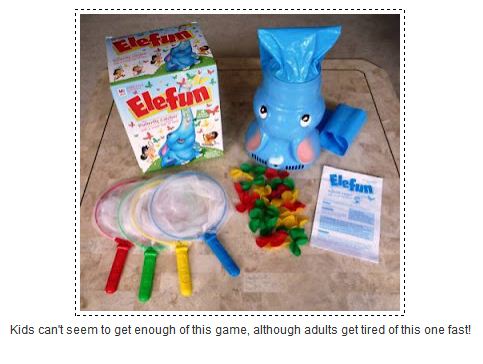SLP Corner: Targeting Language Through Play
by: Tej Sohan, M.A., CCC-SLP TSSLD
My summer vacation took a bit of a turn. I had every intention of relaxing and using my free time to get organized for the upcoming school year and perhaps even plan my wedding (July 26, 2013!!!). However, an opportunity to work with the preschool population arose that I could not pass up. After spending a year with my middle schoolers I definitely needed to jog my memory and re-familiarize myself with functional and multipurpose toys to use in order to support and develop language. This post is a compilation of some of the things I’ve have found useful in the past, as well as toys I used this summer.
Elefun:

This is a classic game where an elephant blows butterflies out of his trunk and are caught with nets. Short utterances can be modeled (e.g. “Pick up,” “Ready, set go!” etc.) as well as requesting, and turn-taking behavior. Important spatial concepts regarding spatial relationship (e.g. front, behind, top), quantity, colors, directions, etc. can also be addressed.
Pound a Ball:
This toy allows you to target color matching, prepositions (e.g. in/out, up/down), requesting, turn-taking, cause/effect etc. Just me mindful of fingers during this activity as children tend to get very excited and occasionally “miss” their target.
Melissa & Doug Sound Puzzles:
Sound puzzles are a great way to teach sounds and basic words as well as cause/effect. The child’s receptive language can easily be targeted by asking them to “point to”, “show me”, or indicate “where?”
Bubbles:
Bubbles are one of my favorite therapy tools because they can be used to assess language skills as well as promote its development. Skills such as eye contact, requesting, signing, sound production, word/phrase production, turn-taking, quantity, etc. can all be addressed.
Jenga:
Classic Jenga with an updated look.Jenga is a classic no frills game that is a tried and true motivator. It reinforces turn-taking behavior and spruces up any speech/language activity. After producing a target sound, answering a question etc. have the student take a turn removing a block. I have also found this to be a great demonstration of concepts like “gentle”, “slow”, “rough”, “careful”, etc.
 |
| Classic Jenga with an updated look. |
Shape Sorter:
In addition to requesting and turn-taking, many concepts can be targeted with a shape sorter. Concepts include: prepositions (“in”, “out”, “on”), color, shapes, directions, full/empty (depending on type of sorter), quantity, etc.
Blocks:
Blocks are an essential part of any SLP’s toolkit as they encourage creativity as well as target prepositions, spatial relationships, directions, quantity, cause/effect, as well as social skills related to turn-taking, and sharing.
These are only a few examples of toys to utilize with the preschool population. I am fully aware that there are a plethora more available. However, I find that the simple toys/games/activities illicit the most language, as there are no bells and whistles to distract the child from their innate need to play.
I really enjoyed working with the little ones this summer, as I gained some insight into the importance of providing an environment of love accompanied with discipline and structure. These are important concepts for the learning of all age groups.
Featured Contributor: Tej Sohan, M.A., CCC-SLP TSSLD of Let’s Talk Speech and Language
Ms. Sohan is a Middle School Speech-Language Pathologist from New York. She is the author of the blog Let’s Talk Speech and Language where she posts about behavior management, free apps, therapy techniques, and more.
dup 2119
PediaStaff is Hiring!
All JobsPediaStaff hires pediatric and school-based professionals nationwide for contract assignments of 2 to 12 months. We also help clinics, hospitals, schools, and home health agencies to find and hire these professionals directly. We work with Speech-Language Pathologists, Occupational and Physical Therapists, School Psychologists, and others in pediatric therapy and education.
